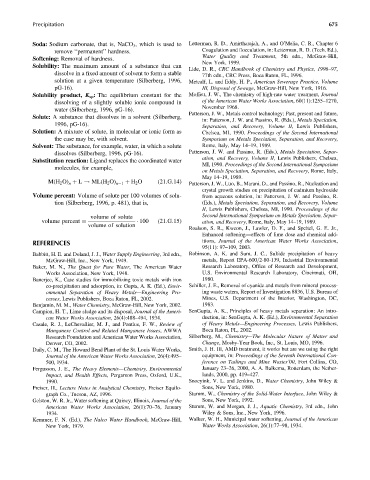Page 720 - Fundamentals of Water Treatment Unit Processes : Physical, Chemical, and Biological
P. 720
Precipitation 675
Soda: Sodium carbonate, that is, NaCO 3 , which is used to Letterman, R. D., Amirtharajah, A., and O’Melia, C. R., Chapter 6
remove ‘‘permanent’’ hardness. Coagulation and flocculation, in: Letterman, R. D. (Tech. Ed.),
Water Quality and Treatment, 5th edn., McGraw-Hill,
Softening: Removal of hardness.
New York, 1999.
Solubility: The maximum amount of a substance that can
Lide, D. R., CRC Handbook of Chemistry and Physics, 1996–97,
dissolve in a fixed amount of solvent to form a stable 77th edn., CRC Press, Boca Raton, FL, 1996.
solution at a given temperature (Silberberg, 1996, Metcalf, L. and Eddy, H. P., American Sewerage Practice, Volume
pG-16). III, Disposal of Sewage, McGraw-Hill, New York, 1916.
Solubility product, K sp : The equilibrium constant for the Moffett, J. W., The chemistry of high-rate water treatment, Journal
dissolving of a slightly soluble ionic compound in of the American Water Works Association, 60(11):1255–1270,
water (Silberberg, 1996, pG-16). November 1968.
Patterson, J. W., Metals control technology; Past, present and future,
Solute: A substance that dissolves in a solvent (Silberberg,
in: Patterson, J. W. and Passino, R. (Eds.), Metals Speciation,
1996, pG-16). Separation, and Recovery, Volume II, Lewis Publishers,
Solution: A mixture of solute, in molecular or ionic form as Chelsea, MI, 1990. Proceedings of the Second International
the case may be, with solvent. Symposium on Metals Speciation, Separation, and Recovery,
Solvent: The substance, for example, water, in which a solute Rome, Italy, May 14–19, 1989.
dissolves (Silberberg, 1996, pG-16). Patterson, J. W. and Passino, R. (Eds.), Metals Speciation, Separ-
ation, and Recovery, Volume II, Lewis Publishers, Chelsea,
Substitution reaction: Ligand replaces the coordinated water
MI, 1990. Proceedings of the Second International Symposium
molecules, for example,
on Metals Speciation, Separation, and Recovery, Rome, Italy,
May 14–19, 1989.
M(H 2 O) n þ L ! ML(H 2 O) n 1 þ H 2 O (21:G:14) Patterson, J. W., Luo, B., Marani, D., and Passino, R., Nucleation and
crystal growth studies on precipitation of cadmium hydroxide
Volume percent: Volume of solute per 100 volumes of solu- from aqueous solution, in: Patterson, J. W. and Passino, R.
tion (Silberberg, 1996, p. 481), that is, (Eds.), Metals Speciation, Separation, and Recovery, Volume
II, Lewis Publishers, Chelsea, MI, 1990. Proceedings of the
volume of solute Second International Symposium on Metals Speciation, Separ-
100 (21:G:15) ation, and Recovery, Rome, Italy, May 14–19, 1989.
volume percent
volume of solution
Roalson, S. R., Kweon, J., Lawler, D. F., and Speitel, G. E. Jr.,
Enhanced softening—effects of lime dose and chemical add-
REFERENCES itions, Journal of the American Water Works Association,
95(11): 97–109, 2003.
Babbitt, H. E. and Doland, J. J., Water Supply Engineering, 3rd edn., Robinson, A. K. and Sum, J. C., Sulfide precipitation of heavy
McGraw-Hill, Inc., New York, 1949. metals, Report EPA-600=2-80-139, Industrial Environmental
Baker, M. N., The Quest for Pure Water, The American Water Research Laboratory, Office of Research and Development,
Works Association, New York, 1948. U.S. Environmental Research Laboratory, Cincinnati, OH,
Banerjee, K., Case studies for immobilizing toxic metals with iron 1980.
co-precipitation and adsorption, in: Gupta, A. K. (Ed.), Envir- Schiller, J. E., Removal of cyanide and metals from mineral process-
onmental Separation of Heavy Metals—Engineering Pro- ing waste waters, Report of Investigation 8836, U.S. Bureau of
cesses, Lewis Publishers, Boca Raton, FL, 2002. Mines, U.S. Department of the Interior, Washington, DC,
Benjamin, M. M., Water Chemistry, McGraw-Hill, New York, 2002. 1983.
Campion, H. T., Lime sludge and its disposal, Journal of the Ameri- SenGupta, A. K., Principles of heavy metals separation: An intro-
can Water Works Association, 26(4):488–494, 1934. duction, in: SenGupta, A. K. (Ed.), Environmental Separation
Casale, R. J., LeChevallier, M. J., and Pontius, F. W., Review of of Heavy Metals—Engineering Processes, Lewis Publishers,
Manganese Control and Related Manganese Issues, AWWA Boca Raton, FL, 2002.
Research Foundation and American Water Works Association, Silberberg, M., Chemistry—The Molecular Nature of Matter and
Denver, CO, 2002. Change, Mosby-Year Book, Inc., St. Louis, MO, 1996.
Daily, C. M., The Howard Bend Plant of the St. Louis Water Works, Smith, J. H. III, AMD treatment, it works but are we using the right
Journal of the American Water Works Association, 26(4):495– equipment, in: Proceedings of the Seventh International Con-
500, 1934. ference on Tailings and Mine Wastes’00, Fort Collins, CO,
Fergusson, J. E., The Heavy Elements—Chemistry, Environmental January 23–26, 2000, A. A. Balkema, Rotterdam, the Nether-
Impact, and Health Effects, Pergamon Press, Oxford, U.K., lands, 2000, pp. 419–427.
1990. Snoeyink, V. L. and Jenkins, D., Water Chemistry, John Wiley &
Freiser, H., Lecture Notes in Analytical Chemistry, Freiser Equilo- Sons, New York, 1980.
graph Co., Tucson, AZ, 1996. Stumm, W., Chemistry of the Solid-Water Interface, John Wiley &
Gelston, W. R. Jr., Water softening at Quincy, Illinois, Journal of the Sons, New York, 1992.
American Water Works Association, 26(1):70–76, January Stumm, W. and Morgan, J. J., Aquatic Chemistry, 3rd edn., John
1934. Wiley & Sons, Inc., New York, 1996.
Kemmer, F. N. (Ed.), The Nalco Water Handbook, McGraw-Hill, Walker, W. H., Municipal water softening, Journal of the American
New York, 1979. Water Works Association, 26(1):77–98, 1934.

